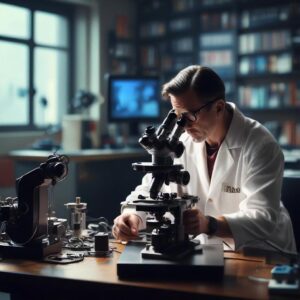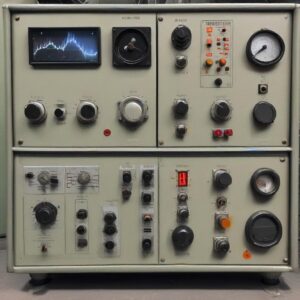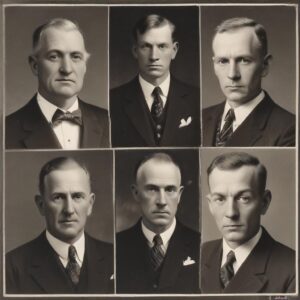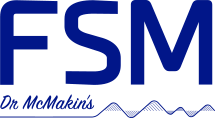


Royal Raymond Rife was an American inventor and early 20th-century researcher who developed a number of microscopes and devices that utilized specific frequencies of electromagnetic radiation. In the 1930s, Rife claimed that he had discovered that certain “universal frequency” waves could be used to destroy pathogenic microorganisms. He developed a device called the Rife Frequency Generator that he believed could selectively kill viruses, bacteria, and other pathogens by subjecting them to their resonant frequency.
Rife’s research gained some attention and support in the 1930s, but his claims and methods were highly controversial and faced significant skepticism from the mainstream medical and scientific community. Much of Rife’s work was not well documented (but most likely destroyed) and there is no evidence that his work was not replicated by independent researchers. However, the written history is that it was not able to be replicated.
The specific frequency ranges he identified and used in his treatments were quite narrow and precise:
- Rife discovered that each pathogenic microorganism had a unique “mortal oscillatory rate” or “resonant frequency” that could be used to destroy it.
- The frequencies Rife reported using ranged from just 1,500 kilohertz (kHz) up to around 20,000 kHz (20 megahertz).
- Some of the specific frequencies Rife identified and used included:
- 1,604 kHz – claimed to be effective against the “cancer virus”
- 2,008 kHz – claimed to be effective against typhoid
- 2,128 kHz – claimed to be effective against the “prostate virus”
- 2,189 kHz – claimed to be effective against streptococcus
Rife believed that by exposing pathogens to these precise resonant frequencies using his Rife Frequency Generator, the microorganisms could be selectively destroyed without harming human cells.
Frequency Specific Microcurrent uses very low-level electrical currents, measured in microamps. These are in the range of 0-1000 microamps. At these levels, they mimic the body’s natural bioelectrical signals.
Unlike Rife’s claims of using specific frequencies to directly kill pathogens, FSM is focused on modulating tissue function and healing rather than directly destroying microorganisms.
Rife’s work was highly controversial at the time, and he faced significant skepticism and opposition from the mainstream medical establishment. This limited his ability to build a large team or network of scientific collaborators who could help validate and replicate his claims and methods.
The American Medical Association (AMA) has historically protected the interests of conventional medical treatments, such as surgery and pharmaceuticals, while actively discrediting any alternative or complementary medical approaches.
- In the early 20th century, the AMA was actively working to discredit and marginalize practitioners of alternative therapies like chiropractic, homeopathy, and naturopathy. The AMA viewed these approaches as unscientific and a threat to the medical establishment.
- The AMA launched campaigns to have certain alternative treatments deemed “unethical” or “illegal”, and successfully lobbied governments to restrict the practice of non-conventional medicine. This helped cement the dominance of pharmaceutical drugs and surgical interventions as the mainstream standard of care.
- The AMA’s actions were driven by financial interests, as the organization derived significant revenue from pharmaceutical companies and medical technology firms. Promoting drug-based and surgical treatments aligned with these industry relationships.
Directed by the AMA, several figures who were powerful in the medical community were tasked with discreting Rife.
- Thomas Hurley – Hurley was a physicist who served on the Special Research Committee that was tasked with evaluating Rife’s virus therapy in the 1930s. Hurley, as far as anyone can tell, was not qualified to make these claims but was under the influence of the AMA.
- George Dock – Dock was a prominent medical doctor who also served on the Special Research Committee. He was a professor of medicine for 30 years and not a practitioner of medicine at the time.
- Harry Marsh – Marsh was the director of the California Bureau of Criminal Identification and Investigation. He was extremely critical of Rife’s work and actively worked to discredit Rife’s research.
- Morris Fishbein – was a particularly staunch and influential critic of alternative and unconventional medical therapies, not just Royal Rife’s work specifically.
As the long-time editor of the Journal of the American Medical Association (JAMA) from 1924 to 1949, Fishbein wielded significant power and authority within the medical establishment. He used this platform to aggressively attack and dismiss a wide range of alternative and complementary treatments that fell outside of mainstream medical orthodoxy.
- He dismissed most alternative therapies as unproven quackery.
- Led attacks against other emerging alternative modalities like chiropractic, homeopathy, naturopathy, and electronic medical devices promoted by figures like Albert Abrams.
- Was a staunch defender of the pharmaceutical and surgical approaches favored by the mainstream medical community. He saw alternative therapies as a threat to the medical establishment’s authority and profits.
- He used his position at JAMA to publish scathing articles and editorials denouncing alternative practitioners and their methods as fraudulent. This helped marginalize many unconventional treatments.
- Fishbein maintained that only treatments that could withstand the gold standard of double-blind, placebo-controlled clinical trials deserved acceptance and adoption by the medical profession.
* Images and some text generated by AI
